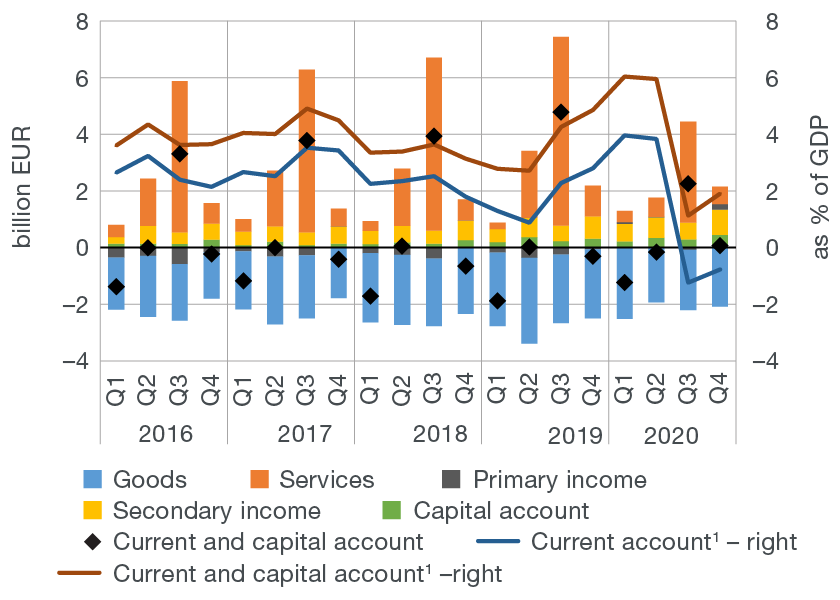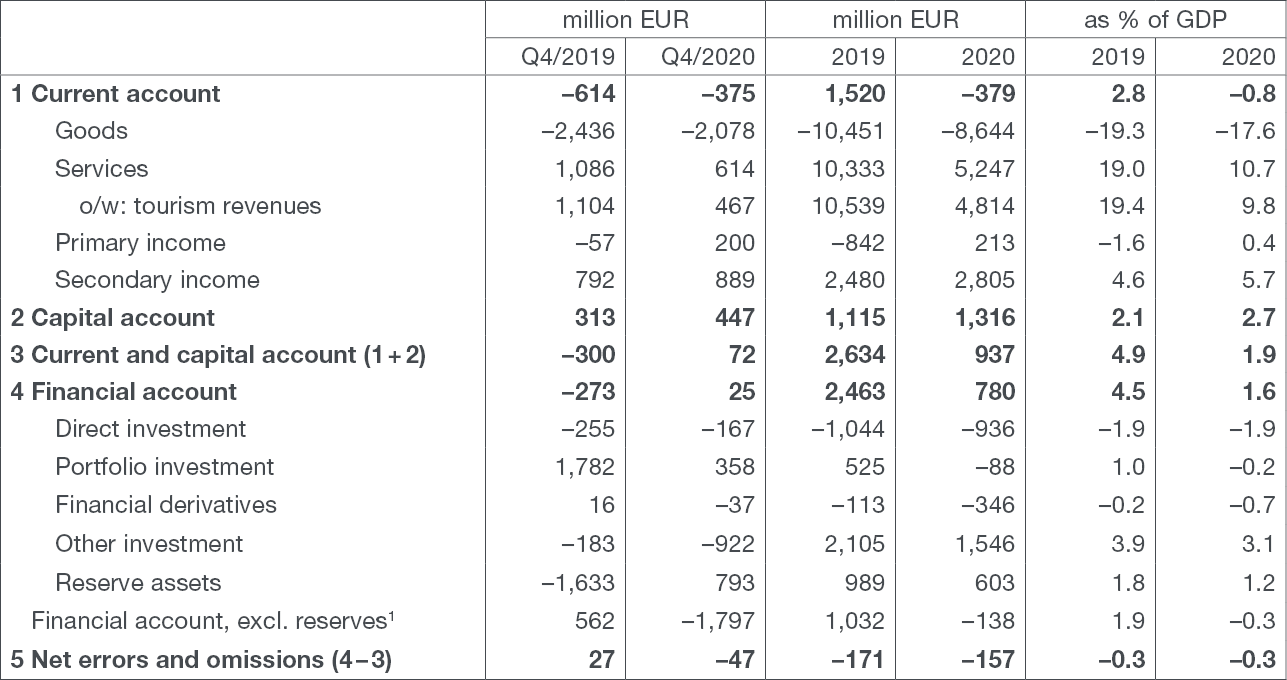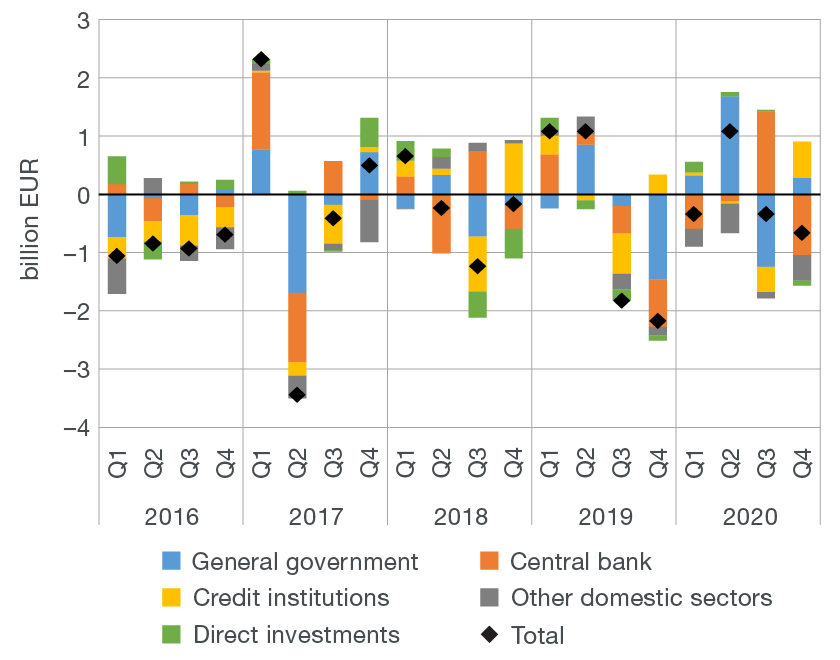From August 2023 the comments on statistics, a short description of selected, recently issued statistical data in the area of monetary statistics and the non-residents sector statistics, are no longer published. They are replaced by Statistical releases.
Comments on the balance of payments, gross external debt and the international investment position in 4Q 2020
The current and capital account of the balance of payments accrued a surplus of EUR 0.1bn in the fourth quarter of 2020, which was an improvement of EUR 0.4bn from the same period of the previous year. On the 2020 level, as a result of the sharp fall in revenues from tourism consumption of foreign guests, the surplus in the current and capital account decreased by 2.9 percentage points of GDP from 2019, to 1.9% of GDP.
Gross external debt stood at 82.7% of GDP at end-2020, up 0.4 percentage points from the end of September, with the increase being entirely due to the sharp decrease in nominal GDP. In the same period, the ratio of net international investment position to GDP deteriorated from –48.8% of GDP to –52.2% of GDP.
The balance in the current and capital account improved noticeably in the last three months of 2020, after having worsened sharply in the second and third quarters due to the seasonal concentration of the tourism spending of foreign guests combined with relatively poor results of the tourist season. The fourth quarter of 2020 thus saw a surplus of EUR 0.1bn, which was notably better than the EUR 0.3bn deficit recorded in the same period of the previous year (Figure 1a). Such developments were largely due to the smaller merchandise trade deficit and, to a slightly lesser extent, the improvement in the primary income account and the larger surplus in the secondary income and capital transaction accounts. By contrast, net services exports continued to be noticeably smaller than in 2019, but they did not have a major impact on the overall current account balance in view of the much smaller seasonal importance of tourism in the last quarter.
Following a sharp contraction in the second quarter of 2020, foreign trade continued to recover for the second quarter in a row. This was particularly true of goods exports, which were 2.6% larger in the fourth quarter of 2020 than in the same period of the previous year. In the same period, imports failed to return to pre-crisis levels and were 4.8% smaller in the last three months of 2020 than in the same period of 2019. As a result, the foreign trade deficit narrowed perceptibly (by 14.7% or EUR 0.4bn). On the other hand, the foreign trade balance in services deteriorated significantly (by EUR 0.5bn) as a result of the sharp fall in revenues from tourism spending of foreign guests (of 57.7%).
The perceptible improvement in the primary income account balance from the same period of the previous year (of EUR 0.3bn) was primarily a result of smaller expenditures on direct equity investments, i.e. a decline in profits of foreign-owned banks. To a lesser extent, the improvement was also a consequence of lower interest expenditures on external debt and larger revenues from compensation of persons temporarily employed abroad. At the same time, total surplus in the secondary income and capital transaction accounts increased (by EUR 0.2bn) owing to a larger positive balance in net transactions with the EU budget.
Figure 1 Balance of payments
| a) Current and capital account | b) Financial account |
 |
 |
1 Sum of the last four quarters.
Note: In the figure showing the financial account, the positive value denotes net capital outflow abroad and the negative value denotes net capital inflow.
Source: CNB.
The financial account of the balance of payments recorded a marginal net capital outflow of EUR 24.8m in the fourth quarter of 2020 (Figure 1b). More specifically, the net capital outflow resulting from an increase in gross international reserves and a decrease in net liabilities on the portfolio investment account was almost completely offset by net capital inflows in the other investment account and the foreign direct investment account.
The net inflow in the foreign direct investment account (of EUR 0.2bn) was largely associated with retained profit of foreign-owned corporations, which was much smaller than in the same period of 2019 due to the sharp fall in bank profits. New equity investments in Croatia grew in the same period, mostly as a result of debt-to-equity swaps.[1] Excluding these transactions, the inflow of new direct equity investment was modest and was mostly driven by investments in real estate and computer programming activities.
The net capital outflow in the portfolio investment account (of EUR 0.4bn) was primarily a consequence of asset growth triggered by investments of institutional investors in foreign shares and equity holdings, while the strong net capital inflow in the other investment account (of EUR 0.9bn) was mostly driven by the large seasonal decrease in net foreign assets of credit institutions. Government liabilities also increased, though to a much lesser extent, as a consequence of the long-term loan through the European instrument for temporary Support to mitigate Unemployment Risks in an Emergency (SURE). By contrast, net liabilities of other domestic sectors decreased, with the particularly strong decrease recorded in central bank liabilities being the result of the smaller volume of repo transactions, which have a neutral impact on the overall financial account balance.[2]
Notwithstanding the smaller volume of repo transactions, gross international reserves rose strongly (by EUR 0.8bn) thanks to the increase in the government's foreign currency deposits with the CNB, as well as the sale of foreign currency to the CNB associated with larger inflows of EU funds to the government’s account and government borrowing under the SURE instrument. To a much lesser degree, reserves also grew on account of a foreign exchange intervention. As a result, gross international reserves stood at EUR 18.9bn at the end of 2020, growing by 2.1% from the end of 2019.
Table 1 Balance of payments

1 Excluding the change in the gross international reserves and foreign liabilities of the CNB. The investment of a portion of international reserves in reverse repo agreements results in a simultaneous change in CNB assets (recorded in the reserve assets account) and liabilities (recorded in the other investment account) and thus has a neutral impact both on changes in the central bank’s net foreign position and the overall financial account balance.
Note: The positive value of financial transactions denotes net capital outflow abroad and the negative value denotes net capital inflow.
Source: CNB.
On the 2020 level, the surplus in the current and capital account was 1.9% of GDP, as against 4.9% of GDP in 2019. The deterioration in the balance was a consequence of the sharp decrease in net exports of services, mostly due to the contraction in tourism revenues, which more than halved from 2019 to 2020. These unfavourable developments were mitigated by an improved balance in other sub-accounts. This particularly refers to the decrease in the foreign trade deficit due to stronger contraction in the imports than in the exports of goods. In addition, the balance in the primary income account improved noticeably owing to lower profitability of domestic banks and enterprises in foreign ownership. Furthermore, the surpluses in the secondary income and capital transaction accounts steadily improved owing to a stronger uptake of EU funds. In line with the fall in the current and capital account surplus, the net capital outflow in the financial account of the balance of payments was much reduced. The net outflow was a consequence of the further decrease in net debt liabilities, mostly those of other domestic sectors.
Gross external debt decreased by EUR 0.7bn in the fourth quarter of 2020 (Figure 2a). The debt of the central bank dropped the most (by EUR 1.0bn) due to the said decrease in the volume of repo transactions. Other domestic sectors, in particular private non-financial corporations, also reduced their debt, including liabilities to affiliated creditors (by EUR 0.5bn). By contrast, an increase was seen in debt of credit institutions (of EUR 0.6bn) and the government (of EUR 0.3bn), due to the borrowing under the SURE instrument. Accordingly, total gross external debt stood at EUR 40.6bn at the end of 2020, i.e. at 82.7% of GDP, which was, due to the fall in nominal GDP, 0.4 percentage points more than at the end of September (Figure 2b).
Figure 2 Gross external debt
| a) Change in gross external debt | b) Stock of gross external debt |
 |
 |
Note: Changes in gross external debt are a result of net transactions of domestic sectors and exchange rate and other adjustments.
Source: CNB.
The net international investment position deteriorated from EUR –24.5bn at the end of September to EUR –25.6bn at the end of 2020. Broken down by sector, the greatest deterioration was observed in the net external position of credit institutions (Figure 3a). The fall in nominal GDP further exacerbated the deterioration in the relative indicator of the net international investment position, from –48.8% of GDP at end-September to –52.2% of GDP at end-December 2020 (Figure 3b). The deterioration was primarily driven by the rise in net equity liabilities due to the effect of price and other adjustments. Net external debt edged up (by EUR 0.1bn) as the decrease in gross external debt ran parallel to a slightly larger reduction in debt claims. Gross debt shrank due to the smaller volume of repo transactions of the central bank, while if these transactions were excluded, the rise in gross debt would marginally exceed the growth in net debt. At the end of 2020, net external debt stood at EUR 8.2bn, or 16.7% of GDP, up by 0.6 percentage points from the previous quarter.
Figure 3 International investment position (net)
| a) Position by sector | b) Relative indicator by type of investment |
 |
 |
Note: The international investment position (net) equals the difference between domestic sectors' foreign assets and liabilities at the end of a period. The negative value of the net international investment position indicates that foreign liabilities of Croatian residents are greater than their foreign assets. Included are assets and liabilities based on debt instruments, equity investments, financial derivatives, and other instruments. Figure 3b includes financial derivatives and other liabilities in the net debt investment position.
Source: CNB.
On the 2020 level, gross external debt decreased in nominal terms due to a favourable impact of exchange rate and other statistical adjustments, whereas the relative indicator deteriorated from 75.3% of GDP at end-2019 to 82.7% of GDP at end-2020 as a result of the fall in nominal GDP. Similarly, the net international investment position improved in absolute terms, while its relative indicator deteriorated from –49.8% of GDP to –52.2% of GDP. However, thanks to the fall in the net debt liabilities of domestic sectors, the relative indicator of the net external debt improved from 17.9% of GDP to 16.7% of GDP.
Data revision
Data on the balance of payments, gross external debt and the international investment position are revised in accordance with the commonly used practice, based on subsequently available data.
Detailed balance of payments data
Detailed gross external debt data
Detailed data on the international investment position
-
These transactions lead to an increase in equity liabilities and a parallel decrease in debt liabilities and do not affect the total change in liabilities in the foreign direct investment account. ↑
-
The investment of a portion of international reserves in reverse repo agreements results in a simultaneous change in CNB assets (recorded in the reserve assets account) and liabilities (recorded in the other investment account) and thus has a neutral impact both on changes in the central bank's net foreign position and the overall financial account balance. ↑
